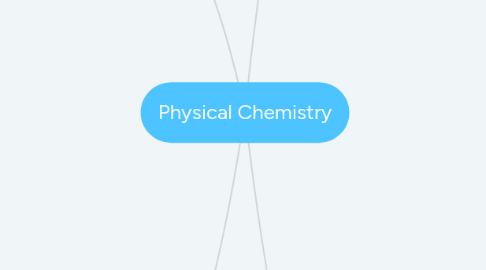
1. Equilibria
1.1. Dynamic Equilibrium
1.1.1. Rate of towards reaction = rate of backward reaction
1.1.2. Changing conditions in a reaction changes position of the equilibrium
1.2. Position of Equilibrium
1.2.1. Temperature
1.2.1.1. Increase
1.2.1.1.1. Position of equilibrium shifts in the endothermic direction
1.2.1.2. Decrease
1.2.1.2.1. Position of equilibrium shifts in the exothermic direction
1.2.2. Pressure
1.2.2.1. Increase
1.2.2.2. Decrease
1.2.2.2.1. Position of equilibrium will shift forwards side of the reaction that produces most gas molecules
1.2.2.3. To predict outcome of pressure change, assess balanced equations to see how many gas molecules are one each side of the equation
1.2.2.4. Catalyst -> speeds up both reactions
1.3. Equilibrium
1.3.1. Doesn't affect position
1.3.2. Affects position
1.3.2.1. Conditions
1.3.2.1.1. Determine relative amounts of substances in reaction
1.4. Reactants A+B -> C + D Reactants C+D -> A + B
1.5. Closed system - system where reactants and products can't be added or removed
2. Energetics
2.1. Combustion of Alcohols
2.1.1. Alcohols combust to release energy -> this can be measured by the temperature change in water
2.1.2. Measuring Variables
2.1.2.1. Mass of the alcohol and burner is measured before and after combusting the fuel
2.1.2.2. Temperature can be measured before and after to find change
2.1.3. Practical Considerations
2.1.3.1. Heat energy is lost to the surroundings -> draft insulators to minimise heat loss
2.1.3.2. Heat energy is used to heat the glass instead of the water
2.1.3.3. Some of the water can evaporate
2.2. Enthalpy Change
2.2.1. Q = M x C x delta T
2.2.2. Heat energy transferred = mass x specific heat capacity x temperature change
2.3. Reaction profiles
2.3.1. Activation energy
2.3.2. Overall energy
2.3.3. Relative energies of reactants and products
2.3.4. progress of reaction X axis energy on Y axis
2.4. Exothermic Reactions
2.4.1. Energy released by forming bonds > energy required to break bonds
2.5. Endothermic Reactions
2.5.1. Energy released by forming bonds < energy required break bonds
3. Rates of Reaction
3.1. Factors affecting
3.1.1. Surface Area
3.1.2. Temperature
3.1.3. Concentration
3.1.4. Pressure (for gases)
3.2. Observing colour change
3.2.1. Set up equipment -> beaker over sheet of paper with black cross
3.2.2. Place in solutions (except acids) into beaker
3.2.3. Pour in acid with a known concentration (independent variable) and present start on stop clock
3.2.4. Repeat with different concentrations
3.3. Collision Theory
3.3.1. Particles must collide for chemicals to happen
3.3.2. Importnat that collisions happen with enough energy (activation energy)
3.3.3. Activation Energy -> Minimum energy with which particles must collide in order to cause a chemical reaction
3.4. Catalysts
3.4.1. Not used up in chemical reactions
3.4.1.1. Can be reused indefinitely
3.4.1.2. Not found in chemical reactions
3.4.2. Enzymes are biological catalysts -> can be seen in washing powders and yeast
3.4.3. Often come as powders, pellets or fine gauzes as these types of substances have high surface areas
3.4.4. Increase rate of chemical reactions by lowering the activation energy -> provides a different reaction pathway
4. Acids, Alkalis and Salts
4.1. pH Scale
4.1.1. Alkalis -> form hydroxide (OH-) ions when dissolved in water. A base that is soluble in water -> bases are proton acceptors
4.1.2. Acids -> form hydrogen ions (H+) ions when dissolved in water. Acids are proton donors
4.1.3. Less than 7
4.1.3.1. 0-3 Strong acid
4.1.3.2. 4-6 Weak acid
4.1.4. Exactly 7
4.1.4.1. Neutral
4.1.5. More than 7
4.1.5.1. 8-10 Weak alkali
4.1.5.2. 11-14 Strong alkali
4.1.6. Measures acidity and alkalinity of a substance
4.1.6.1. Stop clock the moment the cross cannot be seen (time taken is dependent variable)
4.2. Litmus Paper
4.2.1. Acid -> Red
4.2.2. Alkali -> Blue
4.3. Methyl Orange
4.3.1. Acid -> Red
4.3.2. Alkali -> Yellow
4.4. Phenolphthalein
4.4.1. Acid -> colourless
4.4.2. Alkali -> Pink
4.5. Acids form hydrogen ions & alkalis form hydroxide ions when dissolved in water. These combine to form H20, a neutral substance
4.6. Soluble Salts
4.6.1. Made by reacting acids with solid, insoluble substances
4.6.2. Example: Blue Copper Sulfate
4.6.2.1. CuO (s) + H2SO4 (aq) -> CuSO4 (aq) + H2O (l)
4.6.3. Soluble salts dissociate in to their anion and cation (giant lattice breaks)
4.6.4. Insoluble salts do not break up -> giant lattice stays intact
4.7. Required Practical: Separating Mixtures
4.7.1. Produce a pure, dry spam of a soluble sat from an insoluble oxide or carbonate
4.7.2. Preparation
4.7.2.1. Gently warm acid using Bunsen Burner Add insoluble solid until no more reacts
4.7.3. Filtration
4.7.3.1. Filter the solution to remove the excess insoluble solid
4.7.4. Crystallisation
4.7.4.1. Heat solution in an evaporating basin above a beaker of water (Water bath ensures gentle heating) Leave solution to cool and allow more water to evaporate -> solution will become more concentrated -> salt will crystallise
4.8. Neutralisation of Acids
4.8.1. Acid + metal hydroxide -> salt + water
4.8.2. Acid + metal oxide -> salt + water
4.8.3. Acid + Metal carbonate -> salt + water + carbon dioxide
4.9. Strong Bases vs Weak Bases
4.9.1. Strong Base
4.9.1.1. Fully ionise in aqueous solution
4.9.2. Weak Base
4.9.2.1. Don't fully ionise in aqueous solutions
